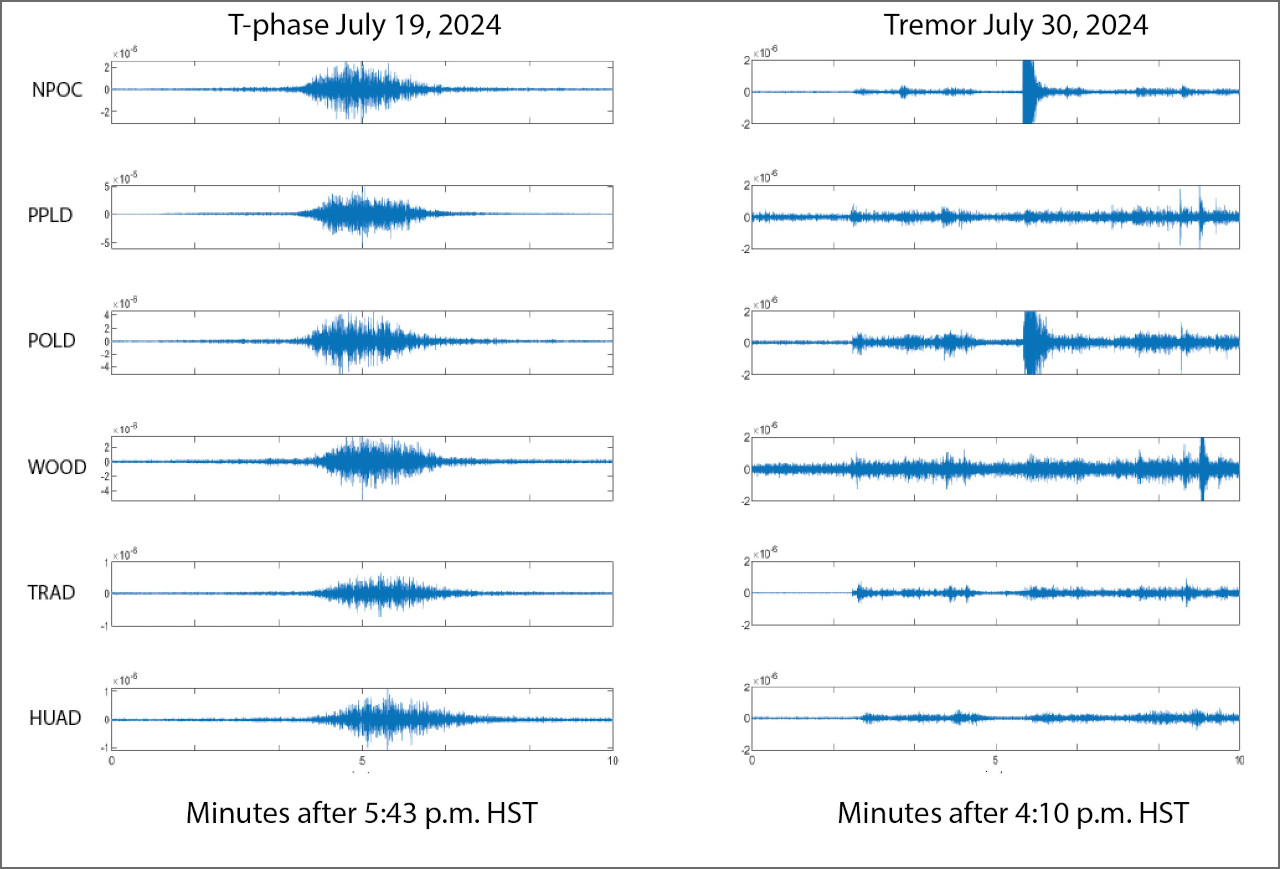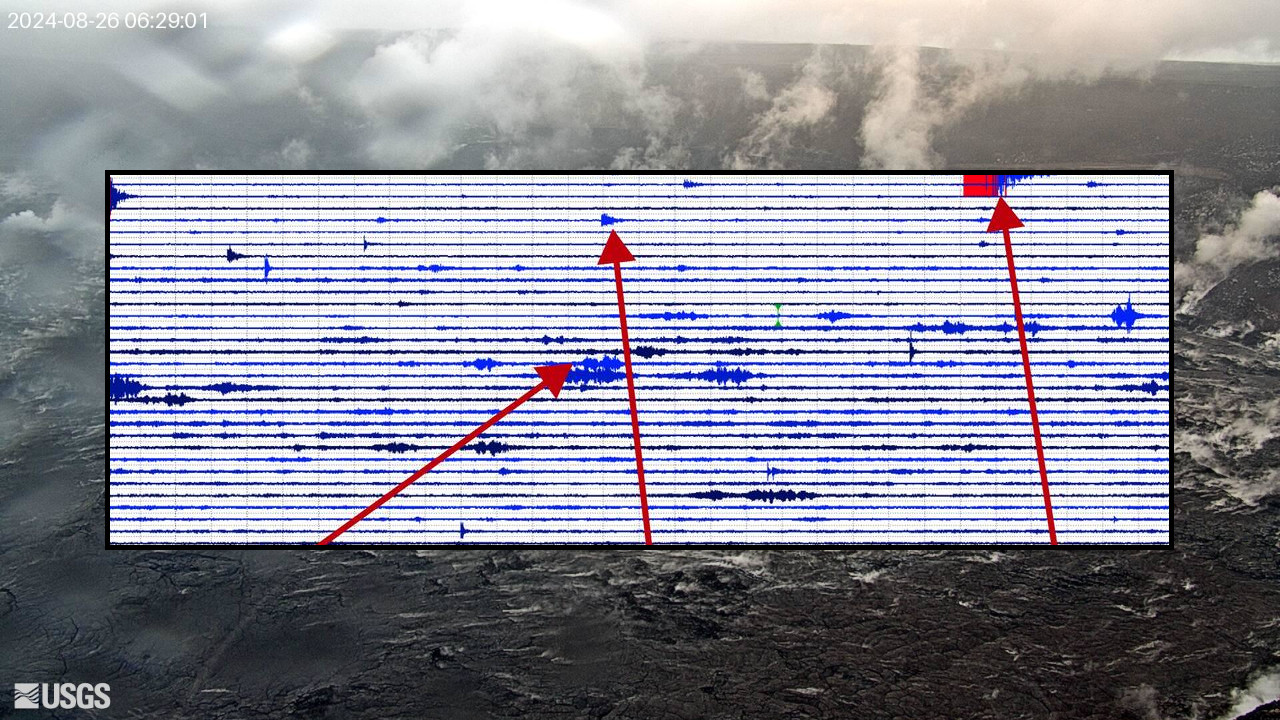(BIVN) – From this week’s Volcano Watch article written by U.S. Geological Survey Hawaiian Volcano Observatory scientists and affiliates:
The Island of Hawaiʻi is one of the most seismically active areas in the world, producing thousands of earthquakes every year. It also commonly produces a signal called tremor that can originate from the volcanic system.
Tremor is characterized by slowly emerging seismic waves which may last for minutes to many days when there are ongoing eruptions. It is important to identify tremor because this signal can be associated with fluid movement, which can sometimes indicate an increased chance of eruption. However, tremor is often difficult to locate because the waves slowly emerge from the background noise and can persist for minutes to weeks or even years—shallow tremor at Kīlauea or Mauna Loa is often directly associated with ongoing eruptive activity.
In contrast, earthquakes usually have sharp onsets which are easy to see. The time that an earthquake signal appears at the many stations that make up the USGS Hawaiian Volcano Observatory (HVO) seismic network can be used to find the earthquake’s location. Instead, the location for tremor bursts is often estimated by looking at the signal size (or seismic amplitude) at multiple seismic stations and then determining the approximate position and depth.
As an example, shallow tremor bursts at Mauna Loa summit might have strong seismic amplitudes at stations near the summit of Mauna Loa, but very weak signals by the time the signal arrives at the Kīlauea seismic stations. By contrast, a tremor burst deep below Pāhala may have almost the same seismic amplitudes on several stations near Pāhala, and only to become weak at seismic stations in Kona, or Hilo.

USGS: “Example waveforms showing a T-phase arriving from the M7.4 Chile earthquake on July 19, 2024 (left). This T-phase event is compared to a local tremor burst deep beneath Pāhala on July 30, 2024 (right). The plots show time for several stations in the HVO network. The T-phase moves more slowly across the network which is represented by systematic delays in the time from the top to the bottom of the left plots on the figure. The plots on the right side of the figure shows the waveforms coming in at about the same time on several stations; this occurs because the Pāhala event is deeper beneath the volcano.”
It is important to note that not all tremor-like signals are related to volcanic activity and in some cases may not be from the Island of Hawaiʻi. A large magnitude-7.4 earthquake deep beneath Chile on July 19 at 3:50 p.m. HST produced strong ground shaking in Chile and was also recorded on the HVO seismic network.
This earthquake also produced a strong hydroacoustic signal (a sound wave traveling through water)— called the T-phase—which was recorded throughout the Pacific basin. T-phases are very different from a tsunami wave and are not hazardous to people. They move at a speed of almost 1.5 kilometers per second (about 3,355 mph) and so would take just under 2 hours to get from Chile to the State of Hawaii.
In this case the wave is transmitted through the ocean predominantly within a horizonal layer called the Sound Fixing and Ranging (SOFAR) channel, which tends to efficiently trap or guide hydroacoustic sound waves. When the T-phase reaches the coast in the State of Hawaii, its energy is converted back into a seismic signal that looks remarkably like local volcanic tremor on the HVO seismic network.
Because HVO is always vigilantly monitoring seismic signals, HVO scientists often need to distinguish between local volcanic tremor and the T-phase from a distant earthquake. The figure here shows an example of local tremor burst deep beneath Pāhala at 4:13 p.m. HST on July 30, 2024. By comparing this local tremor burst to the earlier T-phase event from Chile on July 19, we see that the T-phase event has arrivals that are spread out in time across the HVO seismic network—a result of the slower speed of the acoustic waves in the water. By contrast, the deep volcanic tremor beneath Pāhala arrives at the different HVO stations at about the same time—a result of the local source and faster wave speeds found for basaltic rocks.
HVO scientists can distinguish local tremors from distant earthquakes by assessing arrival times for signals and evaluating their amplitudes. They can further confirm that the observed signal is a T-phase by looking for large events in the global earthquake catalog. This seismic sleuthing is one of the many facets of volcano monitoring in Hawaii.


by Big Island Video News6:56 am
on at
STORY SUMMARY
HAWAIʻI ISLAND - In this week's Volcano Watch article, scientists write about distinguishing seismic signals at Kīlauea and Mauna Loa volcanoes.